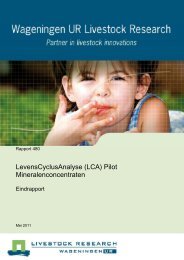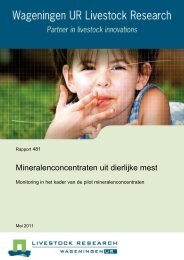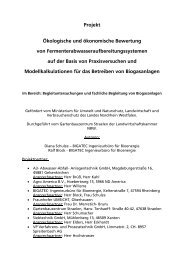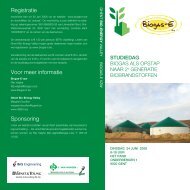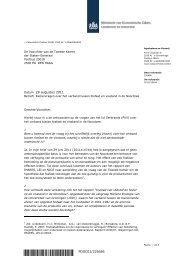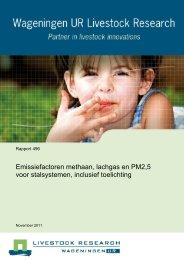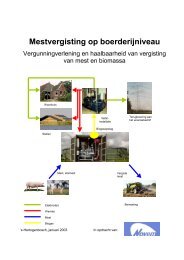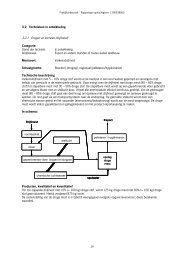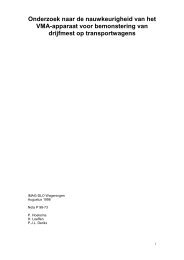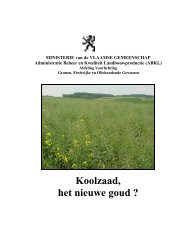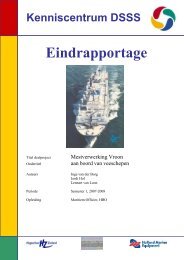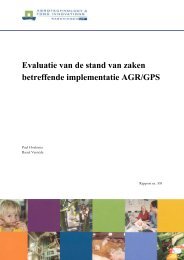Monitoring methane and nitrous oxide reduction by manure treatment
Monitoring methane and nitrous oxide reduction by manure treatment
Monitoring methane and nitrous oxide reduction by manure treatment
Create successful ePaper yourself
Turn your PDF publications into a flip-book with our unique Google optimized e-Paper software.
Report 627<br />
Storage<br />
Manure separation results in a solid <strong>and</strong> liquid fraction which are stored before being further treated or<br />
applied into the field. The separation process results in a change in <strong>manure</strong> composition for both<br />
fractions compared to the raw <strong>manure</strong>, this means that emissions from the storage of both fractions<br />
should be included in the measurement protocol:<br />
In general, the solid fraction has a higher dry matter, organic matter <strong>and</strong> phosphate content<br />
than the raw <strong>manure</strong> (Buiter, 2004; Derikx, 1995; Kool et al., 2006; Mattila & Joki-Tokola,<br />
2003; Pain et al., 1990b; Schepers, 1995; Schröder et al., 2007; Have & Schellekens, 1994;<br />
Timmerman et al., 2005a; Verlinden, 2005).<br />
The liquid (solid) fraction has a lower (higher) total nitrogen content compared to the raw<br />
<strong>manure</strong> (Buiter, 2004; Derikx, 1995; Mattila & Joki-Tokola, 2003; Pain et al., 1990b;<br />
Timmerman et al., 2005a; Verlinden, 2005; Versluis et al., 2005).<br />
The mineral nitrogen content in the liquid (solid) fraction is similar or lower (higher) than the<br />
mineral nitrogen content in the raw <strong>manure</strong> (Buiter, 2004; Derikx, 1995; Kool et al., 2006;<br />
Mattila & Joki-Tokola, 2003; Pain et al., 1990b; Schepers, 1995; Schröder et al., 2007; Have &<br />
Schellekens, 1994; Timmerman et al., 2005a; Verlinden, 2005; Versluis et al., 2005).<br />
Differences in pH between the raw <strong>manure</strong> <strong>and</strong> the solid <strong>and</strong> liquid fractions are not<br />
consistent: sometimes the pH is higher, but in other cases lower after <strong>manure</strong> separation.<br />
Storage of the liquid fraction can lead to even lower N2O emission relative to untreated slurry, but<br />
overall, slurry separation results in a marked increase in N2O emissions during storage of the different<br />
fractions, because of the large emissions from the stored solid fraction. Fangueiro et al. (2008)<br />
showed that, compared to whole slurry, separation of cattle slurry into liquid <strong>and</strong> solid fractions<br />
reduced CH4 emissions <strong>by</strong> 35%, but increased N2O emissions <strong>by</strong> a factor 12. Total greenhouse gas<br />
emissions were reduced <strong>by</strong> 23%. Amon et al. (2006) found that separate storage of the liquid fraction<br />
<strong>and</strong> composting of the solid fraction resulted in a <strong>reduction</strong> in CH4 emissions <strong>by</strong> 42%, <strong>and</strong> an increase<br />
in N2O emissions <strong>by</strong> 10%. Total greenhouse gas emissions were decreased <strong>by</strong> 39%. Martinez et al.<br />
(2003) reported 18-40% lower CH4 emissions from separated pig slurry. However, Dinuccio et al.<br />
(2008) reported either a small 3-4% increase or a small 8-9% decrease in CH4 emissions during<br />
storage of separated slurry depending on temperature <strong>and</strong> slurry type (pig or cattle). Mosquera et al.<br />
(2010) reported 29% lower greenhouse gas emissions from separated pig slurry, but 25% higher<br />
greenhouse gas emissions from separated cattle slurry.<br />
Application<br />
Due to the low total nitrogen content <strong>and</strong> similar or lower mineral nitrogen content in the liquid fraction<br />
compared to the raw <strong>manure</strong>, it is likely that less nitrogen is available to be emitted. Besides, the lower<br />
dry matter content of the liquid fraction makes it easier for the liquid fraction to infiltrate into the soil. All<br />
this will lead to lower NH3 emissions after <strong>manure</strong> application into the field. Amon et al. (2006) found<br />
(significant) lower NH3 emissions after the application of the liquid fraction of dairy cattle compared to<br />
untreated <strong>manure</strong>. Sommer et al. (2006) also reported significant lower NH3 emissions after the<br />
application (broadcasting) of the liquid fraction of co-digested pig <strong>manure</strong> compared to untreated (no<br />
separation, no digestion) <strong>manure</strong>. This was explained <strong>by</strong> the higher infiltration (lower dry matter<br />
20<br />
N 2O CH 4 GHG<br />
Dinuccio et al. (2008) Pig slurry (5 o C) --- 8%<br />
Pig slurry (25 o C) 41%<br />
Cattle slurry (5 o C) --- 4%<br />
Cattle slurry (25 o C) --- 9%<br />
Fangueiro et al. (2008) Cattle slurry 23%<br />
Amon et al. (2006) Cattle slurry<br />
+ wooden lid 39%<br />
Mosquera et al. (2011) Pig slurry 29%<br />
Cattle slurry 25%<br />
Martinez et al. (2003) Pig slurry 18%<br />
Cattle slurry 40%





